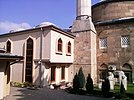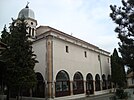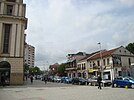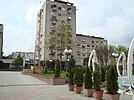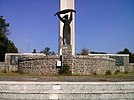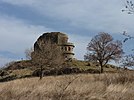Kumanovo
Kumanovo
| |
|---|---|
Kumanovo | |
| Nickname: Kumanovska Republika (Kumanovo Republic) | |
 Map of Kumanovo | |
Location of Kumanovo within North Macedonia | |
| Coordinates: 42°08′09″N 21°43′05″E / 42.13583°N 21.71806°E | |
| Country | |
| Region | |
| Municipality | |
| Founded | 1096 |
| Incorporated | 1519 |
| Named for | tribe Cumans |
| Government | |
| • Type | Town Assembly |
| • Mayor | Maksim Dimitrievski (Independent) |
| • Town Council | Members
|
| Area | |
| • Town | 509.48 km2 (196.71 sq mi) |
| Elevation | 340 m (1,120 ft) |
| Population (2021) | |
| • Town | 75,051 |
| • Density | 207.04/km2 (536.2/sq mi) |
| • Metro | 98,104 |
| Demonym | Kumanovec Kumanovar |
| Time zone | UTC+1 (CET) |
| Postal codes | 1300 |
| Area code | +389 (0) 31 |
| Car plates | KU |
| Patron saints | St. George[1] |
| Date of Liberation | 11 November 1945 |
| Climate | Cfa |
| Website | kumanovo |
Kumanovo (Macedonian: Куманово [kuˈmanɔvɔ] ; Albanian: Kumanovë, Albanian definite form: Kumanova; also known by other alternative names) is a city in North Macedonia and the seat of Kumanovo Municipality, the largest municipality in the country. Kumanovo lies 340 metres (1,115 feet) above sea level and is surrounded by the Karadag part of Skopska Crna Gora mountain on its western side, Gradištanska mountain on its southern side, and Mangovica and German mountain on the Eastern side. Skopje airport also serves Kumanovo.
It has many historical sites. One of the most important sites is the 4,000-year-old megalithic astronomical observatory of Kokino, located 30 km (19 mi) northeast of Kumanovo and discovered in 2001. It is ranked fourth on the list of old observatories by NASA.
In 1912, during the First Balkan War, Serbian forces won a decisive victory over the Ottomans north of the town. The two-day Battle of Kumanovo ended Ottoman authority in Vardar Macedonia which contributed to the region's integration into Serbia, and consequently, into Yugoslavia. The entire region of Macedonia was split in three among Serbia, Greece and Bulgaria after the Treaty of Bucharest in 1913.
The rapid economic, administrative and cultural expansion of Kumanovo began in 1945. It was the site of the 9 June 1999 Agreement signed between FR Yugoslav Generals and the NATO Generals about bringing in a NATO peacekeeping contingent in Kosovo called, the Kosovo Force, or KFOR (Kumanovo Agreement). The town's metal-processing, tobacco, agriculture, footwear and textile industries have made it an economic, trading and cultural center of approximately 135,529 people. It is internationally known for a jazz festival hosting bands from all over the world.
Etymology
[edit]The name of the city in Macedonian, Serbian and Bulgarian is Kumanovo (Куманово). The name in Albanian is Kumanovë or Kumanova. Kumanovo is known as Cumanuva in Aromanian.[2] Kumanovo derives from the name of the Cumans, a western branch of Kipchaks, the tribe that settled in the area in the early 12th century.[3][4][5]

Geography
[edit]Kumanovo is situated in the northeastern part of North Macedonia, near the capital city of Skopje. The coordinates of the city are approximately 42°05'N and 21°40'E. Kumanovo lies 340 metres (1,115 feet) above sea level and is surrounded by
- the Karadag part of Skopska Crna Gora mountain on its western side,
- Gradištanska mountain on its southern side, and
- Mangovica and German mountain on the Eastern side.
Skopje airport also serves Kumanovo.
Climate
[edit]Kumanovo has a humid subtropical climate (Köppen climate classification: Cfa).
| Climate data for Kumanovo | |||||||||||||
|---|---|---|---|---|---|---|---|---|---|---|---|---|---|
| Month | Jan | Feb | Mar | Apr | May | Jun | Jul | Aug | Sep | Oct | Nov | Dec | Year |
| Mean daily maximum °C (°F) | 4.0 (39.2) |
7.6 (45.7) |
12.6 (54.7) |
17.6 (63.7) |
22.3 (72.1) |
26.6 (79.9) |
29.4 (84.9) |
29.6 (85.3) |
25.7 (78.3) |
18.9 (66.0) |
11.5 (52.7) |
5.3 (41.5) |
17.6 (63.7) |
| Daily mean °C (°F) | 0.4 (32.7) |
2.9 (37.2) |
7.2 (45.0) |
11.7 (53.1) |
16.1 (61.0) |
19.8 (67.6) |
22.1 (71.8) |
22.1 (71.8) |
18.5 (65.3) |
13.0 (55.4) |
7.0 (44.6) |
1.9 (35.4) |
11.9 (53.4) |
| Mean daily minimum °C (°F) | −3.2 (26.2) |
−1.7 (28.9) |
1.9 (35.4) |
5.8 (42.4) |
10.0 (50.0) |
13.1 (55.6) |
14.8 (58.6) |
14.6 (58.3) |
11.4 (52.5) |
7.1 (44.8) |
2.6 (36.7) |
−1.5 (29.3) |
6.2 (43.2) |
| Average precipitation mm (inches) | 38 (1.5) |
35 (1.4) |
38 (1.5) |
42 (1.7) |
59 (2.3) |
49 (1.9) |
38 (1.5) |
32 (1.3) |
38 (1.5) |
45 (1.8) |
55 (2.2) |
48 (1.9) |
517 (20.5) |
| Source: Climate-Data.org[6] | |||||||||||||
Neighbourhoods
[edit]- Goce Delčev,
- Zelen Rid,
- Pero Čičo (Banevo Trlo),
- Karpoš (Rajkova Kuka),
- Ajdučka Češma,
- Sokolana,
- Igo Tričkovik (Pukovsko),
- Vera Kotorka (Dobrošane),
- Bedinje,
- Jane Sandanski (Babin Dol),
- Sredorek.
Streets
[edit]- Oktomvriska Revolucija,
- Gorče Petrov,
- Treta Makedonska Udarna Brigada,
- Goce Delčev,
- Narodna Revolucija,
- Nikola Tesla,
- Leninova,
- 11 Oktomvri,
- Moša Pijade,
- Ivo Lola Ribar,
- Srbo Tomovik,
- Tode Mendol,
- Karaorman
- Pero Čičo,
- Esperanto,
- Bajram Shabani,
- Franc Rozman.
- Straso Pindjur
Old neighborhoods
[edit]Most old neighborhood consist of shops and very few houses.
Veleshka Maalo (or Veleshko Maalo) is an old neighbourhood of Kumanovo. The name comes from the merchants from the town of Veles, who passed through the neighbourhood to sell their products by the rivers Vardar and Pchinja, and the Konjarinja villages Studena, Bara and Krasta. The main street, which today is named Narodna Revolucija, was their shortest way to the center of the city.
Karapsko maalo was located across today's south side of Goce Delchev High School through to the end of Mosha Pijade street. The name of the neighborhood came from the Ottomans. Every house in the neighborhood had a yard; neighboring yard were connected with doors, used by anyone chased by the Ottomans. Macedonians, komits and revolutionaries used this scheme to escape to the towns outskirts and the town itself. The Ottomans called it the dark or the secret neighborhood.
Also,
- Varoš maalo,
- Endek maalo,
- Muhamedbegovo maalo,
- Ortabunar maalo,
- Bedinsko maalo,
- Novo maalo,
- Lipkovsko maalo,
- Teke maalo,
- Tatar maalo and
- Muandzisko maalo,
- Sokolana maalo.
Endek maalo was placed across today's city hall on two banks of the former river of Serava.
Old streets
[edit]- Opančarsko sokače,
- Nagorički sokak,
- Proevski sokak,
- Veleški sokak,
- Romanovski sokak,
- Ukumat sokak and
- Vranjsko Dzade.
Military installations
[edit]The military base Boro Menkov[7] is one of the military installations of ARM in Kumanovo. The base was established by the JNA.
MB Hristijan Todorovski Karposh is the second base in Kumanovo, it was also established by the JNA and was inherited by the ARM. Today, part of the installation is converted into a university,[8] and another part was inherited by the Ministry of Interior.[9] There was an idea of turning the base into an economic industrial zone.[10]
In Kumanovo's Elezov kamen area there is also a Military Warehouse Base that operates today.
Police station
[edit]Kumanovo has a police station, under the Ministry of Internal Affairs. The current police chief is Stojanče Veličkovikj.[11]
History
[edit]Prehistory
[edit]The area boasts several prehistoric settlements, among which are
- the Kostoperska Karpa,
- the Bronze Age Gradiste near the village of Pelince,
- the Neolithic site of Mlado Nagoričane,
- the Iron Age tumulus Groblje at Vojnik,
- the Roman Necropolis Drezga of Lopate, and
- the Roman Settlement Vicianus at village of Klečovce.
Middle Ages
[edit]The first written mentioning of the individual modern villages of the Kumanovo region originate in the 14th century. These are, for the most part, found in Serbian charters:
- of King Stefan Milutin,
- Emperor Stefan Dušan,
- Sevastokrator Dejan,
- Jevdokija Dejanović, and Dejan's sons,
- Jovan and
- Konstantin.
In this time, the Kumanovo region (old Žegligovo) received its geographical location and certain settlement picture.[12]
According to a charter of the monastery of Arhiljevica dated 1355, sevastokrator Dejan held a major domain (oblast) east of Skopska Crna Gora. It included the old župe (counties) of Žegligovo and Preševo (modern Kumanovo region with Sredorek and Kozjačija).[13]
Ottoman period
[edit]The town was mentioned in 1530 according to registry of Turkish Devlet Arşivleri as a village in Nogoriçe town, within Kaza of İştip. It was founded by Turkish colonists from Asia Minor and initially was settled by Turks and later by Muslim Albanians. Slavic population entered the town in the late 18th century but its number rose just during early 19th century.[14] Evliya Çelebi described it in 1660–61: "The colony of Kumanovo is situated on the territory of the Skopje sanjak and represents one county. The city is embellished with many rivers and 600 tile-roofs houses. The mosque in the downtown is beautiful, there are tekke, madrassa, hammam, a number of shops and water mills; and the climate is pleasant and agreeable. There are many vineyards and gardens".[15]

In 1689, Karposh, a brigand commander in the region of Dospat (present-day Bulgaria), who served as an Ottoman Christian auxiliary force commander, took advantage of the weakening of the Ottomans and discontent that arose concerning higher Ottoman taxation policies, and organized a revolt while Austria staged an attack on the Ottomans. Karposh's Rebellion quickly spread, resulting in the liberation of Kratovo, Kriva Palanka, Kumanovo, Kačanik and other towns. Then, together with the Austrian army led by Emperor Leopold I, the local Christian population fought to liberate Skopje and Štip. Later changes in the military and political situation in the Balkans had crucial downwards effect on the revolt. The Austrian army was forced to withdraw and the reinforced Ottomans attacked the rebels, taking Kriva Palanka, the rebel stronghold, and then attacked Kumanovo and its newly constructed fortress, where they captured Karposh and put him to death on the Stone Bridge across the Vardar.
Kumanovo became an urban settlement and administrative center of the region at the end of the 16th century or the beginning of the 17th century. Following the turbulent events (including the Karpoš Uprising in 1689) the city experienced a period of stagnation, and by the end of 18th century Kumanovo epitomized an Ottoman provincial town.
In an 1861 book Austrian diplomat Johann Georg von Hahn stated that the town had 650 dwellings, of which 300 were Muslim and 350 were Christian Bulgarian, in addition to 30 Gypsy in the outskirts, while the total population of the town was 3,500.[16]
The Kumanovo Uprising, led by Serb district chiefs of Kumanovo and surrounding districts, was active from 20 January to 20 May 1878 (4 months). The chiefs swore oath in the local church and appealed to Prince Milan IV of Serbia to aid the uprising, and they pledged their devotion and loyalty, and union with Serbia. The rebels were finally defeated by brigadier-general Hafuz Pasha.

The Skopje Revolutionary district of the Internal Macedonian Revolutionary Organization (IMRO) decided in 1894 that it would organize a committee in Kumanovo, which was later established in the house of Jordan Jovčev, member of the local Bulgarian school board.[17] The committee included also the chief Bulgarian teacher in the town Iliya Levkov,[18] the secretary of the Bulgarian metropolitan deputy Traiche Mitev,[19] priest Andon, his son and Bulgarian teacher Psaltir Popandontov,[20] the merchant Zafir Tasev, elder of the Kumanovo Bulgarian community[21] the Bulgarian teacher Zafir Shaklev[22] and Angel Prekodolka. They organized the assassination of Serbian priest Atanasije Petrovic.[23]

First Balkan War
[edit]In October 1912, during the First Balkan War, Serbian forces under the command of General Radomir Putnik won a decisive victory over the Ottomans north of the town. The two-day Battle of Kumanovo ended Ottoman authority in Vardar Macedonia and contributed for region's integration into Serbia, and consequently, into Yugoslavia. The entire region of Macedonia was split in three among Serbia, Greece and Bulgaria after the Treaty of Bucharest in 1913.
World War II
[edit]
The communist resistance in Kumanovo and Prilep began on 11 October 1941. The struggle ended with victory and formation of the Macedonian federated state within the Yugoslav Federation (SFRY). One of the famous partizans from Kumanovo was Hristijan Todorovski-Karpoš shown on the picture. After 1945 Kumanovo experienced fast economic, administrative and cultural development.
Modern history
[edit]It developed economically in the late 19th century (agriculture, handcrafts and trade). Still, industrial development occurred only at the end of the Second World War. The rapid economic, administrative and cultural expansion of Kumanovo began in 1945. Today, it is a modern city with approximately 100,000 inhabitants. It was also the site of the 9 June 1999 Agreement signed between FR Yugoslav Generals and the NATO Generals about bringing in a NATO peacekeeping contingent in Kosovo called, the Kosovo Force, or KFOR (Kumanovo Agreement).[24]
2001 Albanian insurgency and Inter-community relations
[edit]
The Albanian insurgency in Macedonia first started in the mountains outskirts of Tetovo and then spread in May 2001 to the region of Kumanovo mostly to the north. The armed conflict in Kumanovo mainly resulted in a division of the educational system along ethnic lines. All the Albanian-language students left the schools and demanded new schools to be opened. Following this process there is a visible separation in the town affecting the inter-community relations. The Law on Local Self-Government, Article 44 (Sl.vesnik br.5/2002), envisages the establishment of the Commission for Inter-community Relations (CICR). CICR is a consultative body in the Council of the Municipality of Kumanovo and is formed by 12 representatives of the
- Macedonian,
- Albanian,
- Roma,
- Serbian,
- Turkish and
- Vlach
ethnic groups. CICR aims to develop and improve relations between the ethnic communities and to ensure active participation of minorities in decision-making on issues that have ethnic nature and are found in the agenda of the Council of the Municipality of Kumanovo. Other organizations active in bridging the community divide include

- the Center for Intercultural Dialogue (CID),
- Roma community center DROM,
- National Roma Centrum,
- the local Red Cross and others.
One of the most effective systems for supporting the inter-community divide is through the youth centers MultiKulti managed by CID Kumanovo. These centers offer space for youngsters to meet, and apart from learning about each other, they also get youth work support.
2015 clashes
[edit]The NLA had claimed responsibility for a grenade attack on Kumanovo's police station in late 2014.[25] During a police raid on 9 May 2015, a shootout erupted between Macedonian police forces and an armed group.[26] Eight Macedonian policemen and 10 ethnic Albanians were killed, while 37 officers were wounded and hospitalized.[27][28][29][30][31] The attack ended on 10 May 2015 in an operation by the police and armed forces. Thirty men were arrested and charged with terrorism by Macedonian authorities.[32]
Economy
[edit]The town's metal-processing, tobacco, agriculture, footwear and textile industries have made it an economic, trading and cultural center of approximately 135,529 people. Agriculture and trade developed mainly in the 19th century, but the city's modern look was established after the Second World War.
In 2013, the Macedonian Government published a list of companies with the highest revenue. Four companies from Kumanovo are on this list. In 72nd place is KVALITET-PROM DOOEL with 24,643,312 euros, 130th place is DETOIL DOO with 14,912,153 euros, 142nd place is EKSTRA MEIN DOOEL with 13,231,496 euros, and 151st place is 11 OKTOMVRI AD with 12,878,225 euros revenue. The most profitable company in that same year was PROSTOR DOO with 1,458,759.85 euros profit before taxes.
Infrastructure
[edit]Railway
[edit]A railway connection exists between Skopje with Serbia via Kumanovo.
In 2013, rehabilitation of the railway section between Kumanovo and the village of Beljakovce will commence, which is part of the Railway Corridor VIII that will connect North Macedonia with Sofia, Bulgaria and the Black Sea to the East and Tirana, Albania and the Adriatic Sea to the West.
Roads
[edit]
A 40 kilometre (25 miles) highway exists between Skopje and Kumanovo, going near Kumanovo in the north and crossing the border with Serbia. On the section Kumanovo-Miladinovci there is a Pay tool.
Section of the Pan-European Corridor X was put into use in 2010 connecting Kumanovo to the border crossing Tabanovce. The 7.6 kilometres (4.7 miles) highway was built for 4 years and at a cost of 15.5 million Euros.
Another important road goes from Kumanovo to Kriva Palanka and then to the border with Bulgaria.
Air Travel
[edit]Skopje International Airport is 20 km (12 mi) south of Kumanovo.
The E-75 motorway is accessible from Kumanovo.
Sofia Airport is 190 km (118 mi) from the city and Thessaloniki International Airport is 240 km (149 mi).
Near Kumanovo is Adzi Tepe Airport which is without a paved runway.
Culture
[edit]Monuments and Landmarks
[edit]Kumanovo has several prehistoric monuments dating back to the prehistoric period, including:
- Gradište, an archaeological site from the Bronze Age near the village of Pelince
- Near the village of Mlado Nagoričane is another interesting site dating from the period of Neolith.
- Near the village of Lopate is the Drezga place that represents a Roman necropolis.
- One of the most important sites located near the Kumanovo is the 4,000-year-old megalithic astronomical observatory of Kokino, located 30 km (19 mi) northeast of Kumanovo and discovered in 2001. It is ranked fourth on the list of old observatories by NASA.
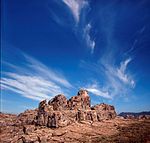
Kokino - Sculpture of Batko Gjorgjija in the city center
- Monument Four Poles also located in the center of the city on the main square,
- Memorial Ossuary and
- House Museum of Hristijan Todorovski Karpoš.
The oldest and biggest church in the town is the St. Nicholas. There are icons from the 13th century in the church. The church represents a masterwork of Andreja Damjanov, an important Macedonian renaissance architect.
- Church Holy Trinity built in 1902,
- Church of St. George,
- Church of St. Petka in the village of Mlado Nagoričane,
- the Karpino Monastery,
- the Ascension of Holy Mother in the village of Matejče,
- Eski Mosque built in 1532,
- Monument Zebrnjak,
- Kumanovska Banja in the village of Proevce and
- Sports Hall Sokolana.
Other landmarks are:
- statue of Woman Fighter,
buildings:
- Zanatski dom and
- Kasapski Krug
and
- ASNOM memorial center in the village Pelince.
Cultural organizations
[edit]
The oldest folklore assemble in North Macedonia, KUD "Panče Pešev" is placed in Kumanovo. This year the assemble is celebrating 80 years of existence.
Kumanovo has
- a library " Tane Georgievski Library",
- cultural center Trajko Prokopiev,
- museum and
- theatre.
Several painting colonies and exhibitions take place every year in Kumanovo or in nearby villages.
Kumanovo is distinguished by its jazz festival which features bands from all over the world. In 2002 the Macedonian bands Foltin and Dragan Dautovski Quartet performed, and in 2003 Macedonian jazz pianist Simon Kiselicki performed in his 'Beneventan Trio'. Every year Kumanovo has a "Days of Comedy" festival, sponsored by the Macedonian Ministry of Culture, featuring comedies from several Macedonian theatres and also from neighbouring Serbia and Bulgaria. Kumanovo municipality was organizing the manifestation "City of Culture 2006".
Demographics
[edit]Historical
[edit]Table below showing historic demographic development according to Yugoslav and Macedonian census data:
| Ethnic group |
census 1948 | census 1953 | census 1961 | census 1971 | census 1981 | census 1994 | census 2002 | census 2021 | ||||||||
|---|---|---|---|---|---|---|---|---|---|---|---|---|---|---|---|---|
| Number | % | Number | % | Number | % | Number | % | Number | % | Number | % | Number | % | Number | % | |
| Macedonians | .. | .. | 14,351 | 61.5 | 20,323 | 66.1 | 28,789 | 62.1 | 36,812 | 60.5 | 40,634 | 62.3 | 42,840 | 60.5 | 43,280 | 57.7 |
| Albanians | .. | .. | 951 | 4.1 | 1,893 | 6.2 | 7,827 | 16.9 | 12,997 | 21.4 | 15,612 | 23.9 | 18,277 | 25.8 | 17,685 | 23.6 |
| Serbs | .. | .. | 1,790 | 7.7 | 2,808 | 9.1 | 3,759 | 8.1 | 4,252 | 7.0 | 5,097 | 7.8 | 4,727 | 6.7 | 4,300 | 5.7 |
| Roma | .. | .. | 1,861 | 8.0 | .. | .. | 3,013 | 6.5 | 4,415 | 7.3 | 2,987 | 4.6 | 4,042 | 5.7 | 2,768 | 3.7 |
| Turks | .. | .. | 3,858 | 16.5 | 2,512 | 8.2 | 1,791 | 3.9 | 936 | 1.5 | 241 | 0.4 | 256 | 0.4 | 125 | 0.2 |
| Vlachs | .. | .. | 12 | 0.1 | .. | .. | .. | .. | 44 | 0.1 | 85 | 0.1 | 108 | 0.2 | 88 | 0.1 |
| Bosniaks | .. | .. | 0 | 0.0 | 0 | 0.0 | 0 | 0.0 | 0 | 0.0 | 0 | 0.0 | 14 | 0.0 | 32 | 0.0 |
| Others | .. | .. | 516 | 2.2 | 3,226 | 10.5 | 1,184 | 2.6 | 1,386 | 2.3 | 577 | 0.9 | 578 | 0.8 | 645 | 0.9 |
| Persons for whom data are taken from administrative sources | 6,128 | 8.2 | ||||||||||||||
| Total | 20,242 | 23,339 | 30,762 | 46,363 | 60,842 | 65,233 | 70,842 | 75,051 | ||||||||
Present-day
[edit]The population of the city of Kumanovo according to the 2002 census numbers 77,561, the majority of which are ethnic Macedonians 62.4% (48,416), with a significant minority of ethnic Albanians 23.7% (18,369) and ethnic Serbs 7.4% (5,746).[34]
The most common mother tongues in the city were the following:
- Macedonian, 45,306 (64.0%)
- Albanian, 18,283 (25.8%)
- Romani, 4,007 (5.7%)
- Serbian, 2,399 (3.4%)
- Turkish, 215 (0.3%)
- others, 632 (0.9%)
The religious composition of the city was the following:
- Eastern Orthodox Christians, 46,766 (66.0%)
- Muslims, 22,483 (31.7%)
- others, 1,593 (2.3%)
People
[edit]
In 2009 marking the 490 years of the first mentioning of the name Kumanovo and 65 years of the liberation of Kumanovo, the Municipality of Kumanovo organized a cultural and artistic program in which they honored the Five impressive people from Kumanovo in the 20th century:
- Vasil Iljoski, writer, dramatist and professor
- Trajko Prokopiev, composer
- Vladimir Antonov, architect
- Hristijan Todorovski Karpoš, partisan
- Saltir Putinski, mayor
Sport
[edit]FK Kumanovo is the main football team from the city and host their games at the Kumanovo Park Stadium. Milano plays its games at Milano Arena. KF Goblen has played in the Macedonian Second Football League and FK Karpoš 93 in the OFS Kumanovo First Division.
Macedonian National Football Team played friendly match with Egypt in Kumanovo on 29 September 1998. The game took place at Gradski Stadium Kumanovo and the scorers for Macedonian team were Srgjan Zaharievski and Dževdet Šainovski. The match ended 2:2.
RK Kumanovo is the handball club that currently competes in the Macedonian Handball Super League. They won the first ever Macedonian Handball Cup back in 1992–93.
Also, Kumanovo is recognized as a box school center, with few names emerged as famous in the 20th century, with Ace Rusevski and Redžep Redžepovski as a leading names.
Media
[edit]Telecommunication operators
[edit] A1 Macedonia (América Móvil)
A1 Macedonia (América Móvil) Green Mobile
Green Mobile IP Systems
IP Systems K-Net
K-Net Lycamobile
Lycamobile Makedonski Telekom (Deutsche Telekom)
Makedonski Telekom (Deutsche Telekom) Mtel (Telekom Srbija)
Mtel (Telekom Srbija) Multimedia Net
Multimedia Net Telekabel
Telekabel Total TV (SBB)
Total TV (SBB)
TV Stations
[edit]Radio stations
[edit]- Radio Bum (in Macedonian)
- Radio Bravo (in Macedonian)
- Jehona 103.5 FM (in Albanian)
- City FM (in Macedonian) (Closed)
Newspapers
[edit]- Ploshtad newspaper (closed)
- Nash Vesnik (closed)
- Dedo Ivan (closed)
- Oktobris (closed)
Gallery
[edit]-
Monument of the Revolution
-
Batko Gjorgjija monument in the square of Kumanovo
-
Kumanovo railway station
-
Kumanovo at night
-
Bislim near Kumanovo
-
Megalithic Observatory Kokino
-
Collective residential area in Kumanovo
-
St. Nikola, main church in Kumanovo
-
Road near Skačkovce
-
Factory in Kumanovo
-
Celebration welcoming the heads of NOV and POM, at liberation of Kumanovo. (11 November 1944)
-
River Pchinja near v.Vojnik
Diplomatic missions
[edit]![]() Romania Honorary Consulate[35]
Romania Honorary Consulate[35]
Twin towns – sister cities
[edit] Banja Luka, Bosnia and Herzegovina
Banja Luka, Bosnia and Herzegovina Bijeljina, Bosnia and Herzegovina
Bijeljina, Bosnia and Herzegovina Câmpina, Romania
Câmpina, Romania Çorlu, Turkey
Çorlu, Turkey Čukarica (Belgrade), Serbia
Čukarica (Belgrade), Serbia Gabrovo, Bulgaria
Gabrovo, Bulgaria Gjilan, Kosovo[37]
Gjilan, Kosovo[37] Gornji Milanovac, Serbia
Gornji Milanovac, Serbia Leskovac, Serbia
Leskovac, Serbia Nikšić, Montenegro
Nikšić, Montenegro Novi Sad, Serbia
Novi Sad, Serbia Pančevo, Serbia
Pančevo, Serbia Plovdiv, Bulgaria
Plovdiv, Bulgaria Vranje, Serbia
Vranje, Serbia
See also
[edit]- List of people from Kumanovo
- List of mayors of Kumanovo
- Kumanovo dialect
- Kumanovo Municipality
- Buildings and Structures in Kumanovo
- Karposh's Rebellion
- Battle of Kumanovo
- Coat of arms of Kumanovo
- Kumanovo Treaty
- Gradski Stadium Kumanovo
- Kumani
- Kumanovo Prison
- Timeline of Kumanovo
- Diocese of Kumanovo and Osogovo
- Muftiship of Kumanovo
References
[edit]- ^ "Five Facts About Saint George, For Saint George's Day - Anglophenia - BBC America". BBC America. Retrieved 7 May 2016.
- ^ The War of Numbers and its First Victim: The Aromanians in Macedonia (End of 19th – Beginning of 20th century)
- ^ Здружение на професори по географија на Северна Македонија „Проф. Д-р Љубе Миленковски“- Скопје, Филип Ѓошевски, Куманичево - едно исчезнато село во Кумановскиот крај.
- ^ Victor Spinei (2009) The Romanians and the Turkic Nomads North of the Danube Delta from the Tenth to the Mid-Thirteenth Century, Brill, ISBN 9789047428800, p. 317.
- ^ Mykola Melnyk (2022) Byzantium and the Pechenegs. The Historiography of the Problem. Brill, ISBN 9789004505223, p. 180.
- ^ "Climate: Kumanovo". Climate-Data.org. Retrieved 18 January 2018.
- ^ about MB Boro Menkov[permanent dead link] (Macedonian)
- ^ Article about the MB H.T. Karposh Archived 16 April 2015 at the Wayback Machine (Macedonian)
- ^ Article about the MVR takeover of MB H.T. Karposh (Macedonia)
- ^ Article about the Economic zone Idea Archived 16 April 2015 at the Wayback Machine (Macedonia)
- ^ "Сектор за внатрешни работи – Куманово".
- ^ Srpsko geografsko društvo 1972, p. 123:
Ти помени већим делом налазе се у даровним повељама српских давалаца: краља Милутина, цара Сте- фана Душана, севастократа Дејана, Јевдокије Дејановић2', Дејано- вих синова – браће деспота Драгаша и "господина" Константина. Као што се зна, тада је ова област – старо Жеглигово до- била учвршћен географски положај и одрећену насеобинску слику
- ^ Историско друштво НР Србије 1951, p. 20:
према повељи манастиру богоро- дичимог ваведења у Архиљевици,50 држао као своју баштину пространу област иеточно од Скопске Црне Горе. Она је обухватала старе жупе Прешево и Жеглигово (данас кумановски крај са Средореком, Козјачијом
- ^ Rozita Dimova, Ethno-Baroque: Materiality, Aesthetics and Conflict in Modern-Day Macedonia, Berghahn Books, 2013, ISBN 1782380418, p. 97.
- ^ Македонските градови во турско време, Зоран Сенев, Киро Герасимов, Кочани, 2004, стр.50
- ^ Johann Georg von Hahn: Reise von Belgrad nach Salonik. Viena: 1861
- ^ Николов, Борис Й. Вътрешна македоно-одринска революционна организация : Войводи и ръководители (1893-1934) Биографично-библиографски справочник. София, Издателство "Звезди", 2001. ISBN 954-9514-28-5, с. 67.
- ^ ЦДА, ф. 246, оп.1, а.е. 211, л. 26. Списък на градските екзархийски учители в Скопската епархия през учебната 1901 – 1902 год. с означение заплатата им, бележки по тяхната деятелност и мнение какво да се прави с всекиго през идущата 1902/3 уч. година.
- ^ Николай Тодоров, Освободителната борба на българите в Македония и Одринско, 1902-1904, Наука и изкуство, 1978, стр. 209.
- ^ Пелтеков, Александър Г. Революционни дейци от Македония и Одринско. Второ допълнено издание. София, Орбел, 2014, ISBN 9789544961022, с. 368.
- ^ Матовъ, Д. Кратка разправия по етнографията на Македония. Периодическо списание XXXIV. София, Българско книжовно дружество, 1889. с. 682 - 683.
- ^ Настевъ, Хр. I-ия випускъ на Скопското българско мъѫко педагогическо училище. Илюстрация Илиндень XII (3) (113). София, Издание на Илинденската организация, мартъ 1940. с. 13.
- ^ В. Илић, Српска четничка акција 1903-1912, Београд 2006, с. 48.
- ^ Reitman, Valerie; Richter, Paul; Dahlburg, John-Thor (23 June 2011). "Yugoslav, NATO Generals Sign Peace Agreement for Kosovo / Alliance will end air campaign when Serbian troops pull out". The San Francisco Chronicle.
- ^ "Ние стоиме зад нападот на полициските станици во Тетово и Куманово". Archived from the original on 13 January 2017.
- ^ Vladimir Gjuzelov; Ben Brumfield (11 May 2015). "Gun battles in former ethnic flashpoint in Macedonia kill 5 police officers". CNN. Retrieved 12 May 2015.
{{cite web}}: CS1 maint: multiple names: authors list (link) - ^ "Macedonia Cuts Number of 'Armed Group' Members Killed in Kumanovo". novinite.com.
- ^ "Prokuroria konfirmon se në Kumanovë janë 10, jo 14 të vrarë". RTKlive.com.
- ^ "Zeka: Lista me të vrarët në Kumanovë është e pakonfirmuar". RTKlive.com.
- ^ "Macedonia charges 30 with terrorism after Kumanovo clashes". BBC News. 11 May 2015.
- ^ Atanasovski, Robert (10 May 2015). "NATO, EU urge 'restraint' as Macedonia clashes leave 22 dead". Agence France-Presse. Yahoo News. Retrieved 12 May 2015.
- ^ "Macedonia charges 30 alleged ethnic Albanian militants over weekend battle that killed 22". Fox News. Associated Press. 11 May 2015. Archived from the original on 14 May 2015. Retrieved 12 May 2015.
- ^ Censuses of population 1948 - 2002 Archived 14 October 2013 at the Wayback Machine
- ^ Macedonian census, language and religion
- ^ mae.ro Consulatul Onorific al României la Kumanovo Retrieved 19.05.2015
- ^ "Службен гласник на Општина Куманово" (PDF) (in Macedonian). Kumanovo. 26 September 2019. p. 615 (11). Retrieved 5 September 2021.
- ^ "Haziri e Damianovski vlerësojnë se Gjilani e Kumanova janë shembulli më i mirë i bashkëpunimit ndërkufitar". kk.rks-gov.net (in Albanian). Retrieved 13 September 2021.
Sources
[edit]- Srpsko geografsko društvo (1972). Glasnik 52 (in Serbian). Srpsko geografsko društvo.
- Историско друштво НР Србије (1951). Историски гласник (in Serbian). Научна књига.


